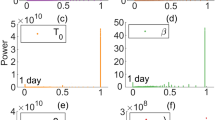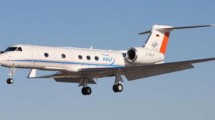Abstract
Air-borne GNSS can provide vertical tropospheric information on different heights compared to the traditional ground permanent stations. However, the decorrelation of heights and tropospheric parameters for GNSS high-kinematic observation remains a challenge. The general stochastic process noise is set to constant for a certain time duration, inducing obvious errors for air-borne GNSS data processing. We proposed a new GNSS zenith total delay (ZTD) estimation method suitable for high-kinematic air-borne observation, in which process noise considers both the temporal and spatial atmosphere state variation assisted by numerical weather models. An unmanned aerial vehicle (UAV) experiment was designed using both traditional models and the proposed dynamic model. For assessments of ZTD, ERA5-ZTD was used as the reference to evaluate external accuracy, and a closed-loop test was proposed to evaluate inner accuracy. The results show that the proposed method outperforms the traditional estimation method, significantly improving the convergence and the accuracy of ZTD results. It achieved an inner accuracy of 4 mm, with an improvement of at least 55.5% over the traditional method. The proposed method can satisfy the demand for real-time data processing and potentially benefit high-precision meteorological applications.





Similar content being viewed by others
Data availability
ERA5 and GFS datasets were obtained from https://rda.ucar.edu/datasets/ds633.0/ and https://rda.ucar.edu/datasets/ds083.3/, respectively. The GNSS results that support the findings are available at https://github.com/zyizhang/DynamicSPN_tests/, and also available at the following Zenodo: https://doi.org/10.5281/zenodo.6539378. The GNSS dataset is available upon request.
References
Ahmed F, Václavovic P, Teferle FN, Douša J, Bingley R, Laurichesse D (2016) Comparative analysis of real-time precise point positioning zenith total delay estimates. GPS Solut 20:187–199. https://doi.org/10.1007/s10291-014-0427-z
Aichinger-Rosenberger M, Weber R, Hanna N (2021) Kinematic ZTD estimation from train-borne single-frequency GNSS: validation and assimilation. Remote Sens 13:3793
Bevis M, Businger S, Chiswell S, Herring TA, Anthes RA, Rocken C, Ware RH (1994) GPS meteorology: mapping zenith wet delays onto precipitable water. J Appl Meteorol Climatol 33:379–386. https://doi.org/10.1175/1520-0450(1994)033%3c0379:Gmmzwd%3e2.0.Co;2
Boehm J, Heinkelmann R, Schuh H (2007) Short Note: A global model of pressure and temperature for geodetic applications. J Geodesy 81:679–683. https://doi.org/10.1007/s00190-007-0135-3
Cai M, Chen W, Dong D, Yu C, Zheng Z, Zhou F, Wang M, Yue W (2016) Ground-based phase wind-up and its application in yaw angle determination. J Geodesy 90:757–772. https://doi.org/10.1007/s00190-016-0908-7
Ding W, Teferle FN, Kazmierski K, Laurichesse D, Yuan Y (2017) An evaluation of real-time troposphere estimation based on GNSS precise point positioning. J Geophys Res: at 122:2779–2790
Douša J, Eliaš M, Václavovic P, Eben K, Krč P (2018) A two-stage tropospheric correction model combining data from GNSS and numerical weather model. GPS Solut 22:77. https://doi.org/10.1007/s10291-018-0742-x
Gong X, Gu S, Lou Y, Zheng F, Ge M, Liu J (2018) An efficient solution of real-time data processing for multi-GNSS network. J Geodesy 92:797–809. https://doi.org/10.1007/s00190-017-1095-x
Gross JN, Watson RM, D’Urso S, Gu Y (2016) Flight-test evaluation of kinematic precise point positioning of small UAVs. International Journal of Aerospace Engineering 2016:1259893. https://doi.org/10.1155/2016/1259893
Guerova G et al (2016) Review of the state of the art and future prospects of the ground-based GNSS meteorology in Europe. Atmos Meas Tech 9:5385–5406. https://doi.org/10.5194/amt-9-5385-2016
Gurturk M, Soycan M (2022) Accuracy assessment of kinematic PPP versus PPK for GNSS flights data processing. Surv Rev 54:48–56. https://doi.org/10.1080/00396265.2020.1865016
Hadas T, Teferle FN, Kazmierski K, Hordyniec P, Bosy J (2017) Optimum stochastic modeling for GNSS tropospheric delay estimation in real-time. GPS Solut 21:1069–1081. https://doi.org/10.1007/s10291-016-0595-0
Hadas T, Hobiger T, Hordyniec P (2020) Considering different recent advancements in GNSS on real-time zenith troposphere estimates. GPS Solut 24:99. https://doi.org/10.1007/s10291-020-01014-w
Henkel P, Sperl A, Mittmann U, Fritzel T, Strauss R, Steiner H (2020) Precise 6D RTK positioning system for UAV-based near-field antenna measurements. In: 2020 14th European conference on antennas and propagation (EuCAP), pp 1–5
Hersbach H et al (2020) The ERA5 global reanalysis. Q J R Meteorol Soc 146:1999–2049
Li X, Dick G, Ge M, Heise S, Wickert J, Bender M (2014) Real-time GPS sensing of atmospheric water vapor: precise point positioning with orbit, clock, and phase delay corrections. Geophys Res Lett 41:3615–3621
Lu C, Li X, Zus F, Heinkelmann R, Dick G, Ge M, Wickert J, Schuh H (2017) Improving BeiDou real-time precise point positioning with numerical weather models. J Geodesy 91:1019–1029. https://doi.org/10.1007/s00190-017-1005-2
Saastamoinen J (1972) Atmospheric correction for the troposphere and the stratosphere in radio ranging satellites. Use Artif Satell Geodesy 15:247–251. https://doi.org/10.1029/GM015p0247
Shi C, Zhao Q, Geng J, Lou Y, Ge M, Liu J (2008) Recent development of PANDA software in GNSS data processing. In: International conference on earth observation data processing and analysis (ICEODPA). SPIE, pp 558–566
Tarek M, Brissette FP, Arsenault R (2020) Evaluation of the ERA5 reanalysis as a potential reference dataset for hydrological modelling over North America. Hydrol Earth Syst Sci 24:2527–2544. https://doi.org/10.5194/hess-24-2527-2020
Thomas ID, King MA, Clarke PJ, Penna NT (2011) Precipitable water vapor estimates from homogeneously reprocessed GPS data: an intertechnique comparison in Antarctica. J Geophys Res: at. https://doi.org/10.1029/2010JD013889
Vaclavovic P, Dousa J, Elias M, Kostelecky J (2017) Using external tropospheric corrections to improve GNSS positioning of hot-air balloon. GPS Solut 21:1479–1489. https://doi.org/10.1007/s10291-017-0628-3
Wang J, Wu Z, Semmling M, Zus F, Gerland S, Ramatschi M, Ge M, Wickert J, Schuh H (2019) Retrieving precipitable water vapor from Shipborne multi-GNSS observations. Geophys Res Lett 46:5000–5008. https://doi.org/10.1029/2019GL082136
Wilgan K, Stauffer R, Meindl M, Geiger A (2020) Comparison of tropospheric parameters from Meteodrone measurements with GNSS estimates from ground-based stations. Adv Space Res 66:2812–2826. https://doi.org/10.1016/j.asr.2020.04.019
Wu JT, Wu SC, Hajj GA, Bertiger WI, Lichten SM (1992) Effects of antenna orientation on GPS carrier phase. In: Astrodynamics. San Diego, CA, pp 1647–1660
Yan X, Ducrocq V, Poli P, Hakam M, Jaubert G, Walpersdorf A (2009) Impact of GPS zenith delay assimilation on convective-scale prediction of Mediterranean heavy rainfall. J Geophys Res. https://doi.org/10.1029/2008JD011036
Zhang W, Lou Y, Haase JS, Zhang R, Liu J (2017) The use of ground-based GPS precipitable water measurements over China to Assess Radiosonde and ERA-interim moisture trends and errors from 1999 to 2015. J Clim 30:7643–7667
Zhang Z, Lou Y, Zhang W, Wang H, Zhou Y, Bai J (2021) On the assessment GPS-based WRFDA for InSAR atmospheric correction: a case study in Pearl River Delta Region of China. Remote Sens 13:3280
Acknowledgments
This work is supported by the National Key Research and Development Program of China (Grant 2021YFC3000501), the National Natural Science Foundation of China (Grant 41961144015), the National Key Research and Development Program of China (Grant 2020YFB0505602), and the Fundamental Research Funds for the Central Universities (Grant 2042022kf1198).
Author information
Authors and Affiliations
Contributions
Conceptualization: ZZ, YL, WZ; Resources: YL, WZ, ZW, CS; Methodology: ZZ, YL, WZ; Formal analysis and investigation: ZZ; Writing - original draft preparation: ZZ; Writing—review and editing: YL, WZ, YZ, JB, ZZ; Funding acquisition: YL, WZ, ZW; Supervision: YL, WZ.
Corresponding author
Ethics declarations
Conflict of interests
The authors declare no competing interests.
Additional information
Publisher's Note
Springer Nature remains neutral with regard to jurisdictional claims in published maps and institutional affiliations.
Rights and permissions
Springer Nature or its licensor (e.g. a society or other partner) holds exclusive rights to this article under a publishing agreement with the author(s) or other rightsholder(s); author self-archiving of the accepted manuscript version of this article is solely governed by the terms of such publishing agreement and applicable law.
About this article
Cite this article
Zhang, Z., Lou, Y., Zhang, W. et al. Dynamic stochastic model for estimating GNSS tropospheric delays from air-borne platforms. GPS Solut 27, 39 (2023). https://doi.org/10.1007/s10291-022-01375-4
Received:
Accepted:
Published:
DOI: https://doi.org/10.1007/s10291-022-01375-4




